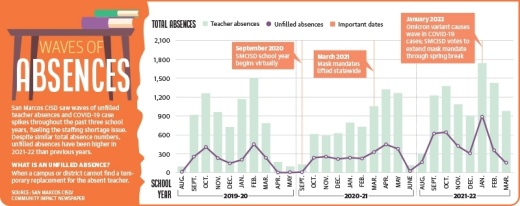With the impending return to school, a post was made on the SMCISD Facebook page reminding families of the mask mandate that was in place.
Despite the mandate, SMCISD had 877 unfilled absences in January, only about 30 fewer than in Hays CISD, even though SMCISD has fewer than half the amount of HCISD students.
Oftentimes, when there are unfilled absences and a campus or district cannot find a temporary replacement for an absent teacher, students can be redistributed to other classes, according to district policy.
In the first week back, there were about 50 COVID-19 cases among students and staff and a 44% fill rate of absences; in the second week back, there were nearly 250 COVID-19 cases and a fill rate of 54%, according to the SMCISD COVID-19 dashboard and unfilled absence data.
From the beginning of the school year to March, there were a total of 9,045 absences. January had the most at 1,741, followed by February at 1,427.
The fill rate continued to fluctuate between 40% and 50% throughout January, and by March, fill rates were up to anywhere from 75% to 99%.
Despite the nationwide shortage of staff, SMCISD does shine past other districts in the transportation department, according to Transportation Director Ryan Hall. Bus driver shortages have affected Comal, Dripping Springs and Lake Travis ISDs, to name a few, in recent months.
“It’s been unusual compared to some of our surrounding districts who have struggled with recruitment and being able to retain bus drivers,” Hall said. “Even with challenges, we’ve never had to delay students getting to school or home by more than 15, 20 or 30 minutes.”
Hall credits the strength of the department to yearly raises and stipends that he thinks have helped with retention.
As previously reported by Community Impact Newspaper, in July 2021, SMCISD passed a one-time $250 stipend to staff who received the COVID-19 vaccine and another $100 stipend in December for those who received a booster.
However, there is still a downward trend of interest in the education field at the primary, secondary and college levels, according to Glenna Billingsley, an associate professor at Texas State University.
She said people are no longer interested in becoming teachers, and she has seen fewer students major in education. Once the pandemic set in and classes went virtual, she recalled retirements from professors and staff.
Combating shortages
To get ahead of staffing shortages and produce high-quality educators, In February SMCISD started to offer a daily rate of $105 to those in the Texas State University College of Education teacher residency program through a grant from the University-School Partnerships for the Renewal of Educator Preparation (US PREP) national center.
While the residency program is not new, this is the first year the students have been paid for their work, SMCISD Executive Director of Communications Andrew Fernandez said.
“We felt it was just the right time to really engage the partnership with Texas State and make sure that great teachers were coming to San Marcos CISD and staying in San Marcos CISD,” Fernandez said. “Being able to go into the residency program, ... get a year’s experience and build those relationships, it’s a unique opportunity, and we don’t want to lose any of those residency students.”
At the State of the City address April 7 in San Marcos, Superintendent Michael Cardona said many of the students in the residency program have already been hired for the upcoming school year.
In addition to the residency program partnership that feeds into the district, there is also a student organization called Texas Association of Future Educators, which allows students to explore and gain insight on the teaching profession.
However, it is more observation based, whereas the residency program is a fully hands-on experience, Fernandez said.
The main push for the stipend and programs, Fernandez said, is in response to the teacher shortage. It is a proactive approach to ensure Texas State University students can build relationships with the SMCISD community and find a home in the district.






